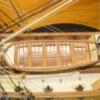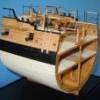
Bob Cleek
-
Posts
3,374 -
Joined
-
Last visited
Reputation Activity
-
 Bob Cleek reacted to Chuck in Gutermann Polyester thread for making rope.
Bob Cleek reacted to Chuck in Gutermann Polyester thread for making rope.
Not yet.....I will put one together once I start production. But remember that the thread I am using is not the same. I am using a blended thread now which is made in the USA. The sizes are different. I never made a chart when I was making the stuff for the museum using the Guttemann stuff. I will check my notes though.
Chuck
-
 Bob Cleek got a reaction from davec in Jointer question/recommendation
Bob Cleek got a reaction from davec in Jointer question/recommendation
Yep. You can't beat "old 'arn." I have a four inch 1950 vintage Craftsman, made by King-Seely, I believe. It works great for shorter stock. A 6" jointer would handle larger stock better, but I don't use it for much more than three or four foot long stock. A 6" jointer is a relatively large machine.
I rarely joint raw wood down to square finished on all sides. I just joint it until I have a flat wide enough to then cut pieces off on the band or table saw. Putting a round piece of wood through a table saw gives me the heeby-jeebies. One little wobble and it's likely to be coming back at you.
-
 Bob Cleek got a reaction from dvm27 in Germania Nova 1911 by KeithAug - FINISHED - Scale 1:36 - replica of schooner Germania 1908
Bob Cleek got a reaction from dvm27 in Germania Nova 1911 by KeithAug - FINISHED - Scale 1:36 - replica of schooner Germania 1908
Those "mystery padeyes" continue to intrigue me, although the mystery may never be solved. At the risk of "flogging the poodle," I wonder if they might be for securing the sheets of a loose-footed storm trisail? Just one more option in the "multiple choice test" where the answer "none of the above" may be the only correct one.
Beautiful work on the skylight bars! Thanks for sharing your fine workmanship.
-
 Bob Cleek got a reaction from mtaylor in Jointer question/recommendation
Bob Cleek got a reaction from mtaylor in Jointer question/recommendation
Yep. You can't beat "old 'arn." I have a four inch 1950 vintage Craftsman, made by King-Seely, I believe. It works great for shorter stock. A 6" jointer would handle larger stock better, but I don't use it for much more than three or four foot long stock. A 6" jointer is a relatively large machine.
I rarely joint raw wood down to square finished on all sides. I just joint it until I have a flat wide enough to then cut pieces off on the band or table saw. Putting a round piece of wood through a table saw gives me the heeby-jeebies. One little wobble and it's likely to be coming back at you.
-
 Bob Cleek got a reaction from Dan Vadas in 2-6-6-4 "Bulgar" Steam Locomotive by Dan Vadas - Modelik - 1:25 - CARD - FINISHED
Bob Cleek got a reaction from Dan Vadas in 2-6-6-4 "Bulgar" Steam Locomotive by Dan Vadas - Modelik - 1:25 - CARD - FINISHED
Beautiful!
-
 Bob Cleek reacted to Roger Pellett in Jointer question/recommendation
Bob Cleek reacted to Roger Pellett in Jointer question/recommendation
I have a Delta Rockwell 4” Jointer that I bought new in the late 1970’s. It is a great tool. It is solidly built, all cast iron. Over the years, I have used it to mill parts for restoring four wooden canoes, and for reducing rough sawn lumber to billets for ship model building. I have also used it for building ship model glass cases. I do not build furniture or cabinetry. I have never needed anything larger.
if you can find one of these used that can be cleaned up you will have a real workhorse. In my opinion, “vintage” power tools are much better tan most new ones as they don’t contain plastic parts.
i will be down in my workshop later today and I’ll send you a photo.
Roger
-
 Bob Cleek got a reaction from mtaylor in Rigging Diameters?
Bob Cleek got a reaction from mtaylor in Rigging Diameters?
Not good news, Allan. If you do get it to open, please post the "fix!" The raw data is available in various texts, but this spreadsheet program really seems to be a much easier way to access it.
Thanks much!
-
 Bob Cleek got a reaction from mtaylor in Rigging Diameters?
Bob Cleek got a reaction from mtaylor in Rigging Diameters?
I've checked the rigging spread sheet done by Dan. I can't seem to get it to respond. It appears to be a "dead" link. I can get to it, but it doesn't work. Is it possible to revive it. It looks woderful.
-
 Bob Cleek got a reaction from KeithAug in Germania Nova 1911 by KeithAug - FINISHED - Scale 1:36 - replica of schooner Germania 1908
Bob Cleek got a reaction from KeithAug in Germania Nova 1911 by KeithAug - FINISHED - Scale 1:36 - replica of schooner Germania 1908
Those "mystery padeyes" continue to intrigue me, although the mystery may never be solved. At the risk of "flogging the poodle," I wonder if they might be for securing the sheets of a loose-footed storm trisail? Just one more option in the "multiple choice test" where the answer "none of the above" may be the only correct one.
Beautiful work on the skylight bars! Thanks for sharing your fine workmanship.
-
 Bob Cleek reacted to Kevin Kenny in Naparima by Kevin Kenny - FINISHED
Bob Cleek reacted to Kevin Kenny in Naparima by Kevin Kenny - FINISHED
Ship in the night. Naparima.
IMG_3850.MOV -
 Bob Cleek reacted to Kevin Kenny in Naparima by Kevin Kenny - FINISHED
Bob Cleek reacted to Kevin Kenny in Naparima by Kevin Kenny - FINISHED
Air scoops adjusted and installed
-
 Bob Cleek got a reaction from mtaylor in Good tool to cut perfect squares
Bob Cleek got a reaction from mtaylor in Good tool to cut perfect squares
True in theory. In practice, once the tar got tracked all over the decks and dust and dirt and decomposed tow all mixed in, both the seams and the decks were black, unless it was a naval vessel or fancy packet with regularly holystoned decks. The tar would soften in the hot sun and get tracked everywhere.
-
 Bob Cleek reacted to Jaager in Good tool to cut perfect squares
Bob Cleek reacted to Jaager in Good tool to cut perfect squares
Yellow PVA (e.g. Titebond II) has gap filling properties. PVA fixed with wood flour from the same wood has even more.
With the task of filling the outer perimeter gap between POB moulds - for to give support for planking and allow for needing only one layer:
Avoid Balsa at all costs.
Basswood comes (or used to come) in packs of sheets 1/32 - 1/4" on line or from mega craft stores. Easy to work but kinda dear on wallet damage.
Construction Pine from ~Home Depot or Lowes (Slows as my framing contractor in the Blue Grass called them) 2x4, 1x4, even thinner -easy to cut, soft put sturdy - avoid sap/resin stock.
anyway, no one will see it, so as long as it stays bonded in place, close enough is good enough.
If you paint, fillers take care of gaps.
If it is wood with clear finish, as tight a tolerance as your skill allows. If a piece does not measure up, toss it into a scrap box and start again. You will know and you will always know if you just settle. almost no one else will notice or know that it is less than perfect, but you will.
editorial:
decks - make the caulking seams under scale and if the vessels is before 1860 - color it Walnut, not black Drake's well was 1859.
-
 Bob Cleek got a reaction from mtaylor in Germania Nova 1911 by KeithAug - FINISHED - Scale 1:36 - replica of schooner Germania 1908
Bob Cleek got a reaction from mtaylor in Germania Nova 1911 by KeithAug - FINISHED - Scale 1:36 - replica of schooner Germania 1908
Those "mystery padeyes" continue to intrigue me, although the mystery may never be solved. At the risk of "flogging the poodle," I wonder if they might be for securing the sheets of a loose-footed storm trisail? Just one more option in the "multiple choice test" where the answer "none of the above" may be the only correct one.
Beautiful work on the skylight bars! Thanks for sharing your fine workmanship.
-
 Bob Cleek got a reaction from mtaylor in Good tool to cut perfect squares
Bob Cleek got a reaction from mtaylor in Good tool to cut perfect squares
I'll bet you'll find your shooting board to serve its purpose well. Measurement tolerances with wood are not as exacting as with metal. Wood moves more than metal does with changes in ambient humidity. If it fits without looking loose, its plenty good for modeling. Remember the old saying, "Never send a rocket scientist to do a wood-butcher's job!"
-
 Bob Cleek got a reaction from Canute in Can I bake it? instead of soldering. Oven soldering?? (edited by admin)
Bob Cleek got a reaction from Canute in Can I bake it? instead of soldering. Oven soldering?? (edited by admin)
The Smith Little Torch runs on oxygen and propane, acetylene, or MAPP gas. (I believe they also run on natural gas, which is about the same as propane.) I don't know of any small propane-only torches. Propane-only torches seem to start with the regular "plumber's torch" sizes which are too large for small modeling work. (These aspirate air into an integral combustion chamber.) Small non-oxygen torches seem to be limited to the small butane torches.
Running straight propane through the Little Torch will get you a flame, but it won't be hot enough to be of any use. Think "butane cigarette lighter." It's the oxygen that causes the intense heat.
I don't think you can go too far wrong with the Smith Little torch with oxygen and propane for modeling work. The disposable Bernzomatic oxygen bottles are priced comparably to the Bernzomatic disposable propane, acetylene, and MAPP gas bottles. These sizes last for a long time doing small work and are compact and easy to store. If you are a gas cutter and welder, you can use large oxygen tanks, of course, but the Bernzomatic disposable bottles are the least expensive way to go if you aren't already "cookin' with gas."
-
 Bob Cleek got a reaction from paulsutcliffe in Germania Nova 1911 by KeithAug - FINISHED - Scale 1:36 - replica of schooner Germania 1908
Bob Cleek got a reaction from paulsutcliffe in Germania Nova 1911 by KeithAug - FINISHED - Scale 1:36 - replica of schooner Germania 1908
Those "mystery padeyes" continue to intrigue me, although the mystery may never be solved. At the risk of "flogging the poodle," I wonder if they might be for securing the sheets of a loose-footed storm trisail? Just one more option in the "multiple choice test" where the answer "none of the above" may be the only correct one.
Beautiful work on the skylight bars! Thanks for sharing your fine workmanship.
-
 Bob Cleek got a reaction from Riotvan88 in Good tool to cut perfect squares
Bob Cleek got a reaction from Riotvan88 in Good tool to cut perfect squares
I'll bet you'll find your shooting board to serve its purpose well. Measurement tolerances with wood are not as exacting as with metal. Wood moves more than metal does with changes in ambient humidity. If it fits without looking loose, its plenty good for modeling. Remember the old saying, "Never send a rocket scientist to do a wood-butcher's job!"
-
 Bob Cleek got a reaction from Keith Black in Germania Nova 1911 by KeithAug - FINISHED - Scale 1:36 - replica of schooner Germania 1908
Bob Cleek got a reaction from Keith Black in Germania Nova 1911 by KeithAug - FINISHED - Scale 1:36 - replica of schooner Germania 1908
Those "mystery padeyes" continue to intrigue me, although the mystery may never be solved. At the risk of "flogging the poodle," I wonder if they might be for securing the sheets of a loose-footed storm trisail? Just one more option in the "multiple choice test" where the answer "none of the above" may be the only correct one.
Beautiful work on the skylight bars! Thanks for sharing your fine workmanship.
-
 Bob Cleek reacted to BANYAN in Germania Nova 1911 by KeithAug - FINISHED - Scale 1:36 - replica of schooner Germania 1908
Bob Cleek reacted to BANYAN in Germania Nova 1911 by KeithAug - FINISHED - Scale 1:36 - replica of schooner Germania 1908
Hi Keith, a thought from left field: those brackets look substantial, if there are another set forward, could these be lifting points for lifting the hull out of the water? Unlikely noting the size of the hull but...
cheers
Pat
-
 Bob Cleek reacted to mtaylor in Germania Nova 1911 by KeithAug - FINISHED - Scale 1:36 - replica of schooner Germania 1908
Bob Cleek reacted to mtaylor in Germania Nova 1911 by KeithAug - FINISHED - Scale 1:36 - replica of schooner Germania 1908
Keith, are these fore and aft? I'm thinking lifting lugs when they need to pull the boat out of the water.
-
 Bob Cleek reacted to reklein in unknown type of wood
Bob Cleek reacted to reklein in unknown type of wood
I looked at Sauers catalog for veneers. You may have either Zebrawood,my first choice,or Macassar ebony. Pretty stuff.
-
 Bob Cleek got a reaction from mtaylor in Newbie planking question
Bob Cleek got a reaction from mtaylor in Newbie planking question
Soft, "fuzzy" wood species can generally be sanded perfectly smooth if, prior to the final finish sanding, they are sealed with shellac (2 pound cut as sold commercially, e.g. Zinsser "Bullseye" brand.) The shellac soaks into the wood and hardens it so it can be sanded without raising the "fuzz."
-
 Bob Cleek got a reaction from Keith Black in unknown type of wood
Bob Cleek got a reaction from Keith Black in unknown type of wood
Based on the picture alone, my wild guess would be spalted satin walnut. https://www.wood-database.com/sweetgum/
Satin walnut is not a walnut at all, but liquidambar, or "sweetgum" in the US. (No relation to Australian "gums.") The spalting (a fungus) causes the black figuring. It's used in fine custom furniture and is an excellent modeling wood, though spalted stock is usually reserved for its appearance. The liquidambar or sweetgum tree is widely distributed in the US and often planted as an ornamental, although it has a nasty habit of horizontal root growth that destroys sidewalks. It's not commercially milled much, so you usually have to cut your own and mill it. It's often found in municipal woodpiles and tree services will sometimes have logs available.
https://www.wood-database.com/sweetgum/
-
 Bob Cleek reacted to Jaager in Newbie planking question
Bob Cleek reacted to Jaager in Newbie planking question
Edge bending is trying to take wood into a shape that is against its nature. Some species take to this better than others. A lot of the species supplied in kits - look to be brittle - as well as having out of scale pores. One of the better species for serious bending is Holly and stock that has been infected with Blue Mold will work just as well . I suspect that infected Holly is not available commercially. Accepting it makes self harvesting an easier proposition than insisting on snow white stock which requires cold season harvest and immediate placement into a kiln. Commercial white Holly is becoming very expensive and the color matches nothing that was used on an actual ship. I have seen Basswood or Lime taking a serious bend. The grain, color and pore structure are spot on. Those species are too soft, fuzzy, and friable for me, though.
Looking at the build in your link, the wale does not seem to edge bend all that much. The run of the planking appears to follow that of the wale, and not the rail. The stern is planked with short runs of planking with little edge bending. A ship that got into wave action requiring serious strength at that upper stern location would be in more trouble than strength there would help.







